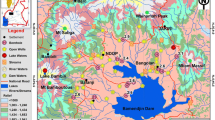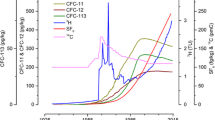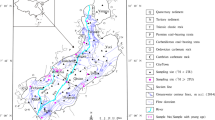Abstract
Groundwater age has been used to map renewability of water resources within four groups: strong, partial, and rare renewability, and non-renewable. The Baiyang alluvial fan in NW China is a representative area for examining groundwater recharge from river infiltration and for mapping groundwater renewability, and it has been investigated using multiple isotopes and water chemistry. Systematic sampling included 52 samples for 2H and 18O analysis and 32 samples for 3H, 13C and 14C analysis. The δ13C compositions remain nearly constant throughout the basin (median −12.7‰) and indicate that carbonate dissolution does not alter 14C age. The initial 14C activity of 80 pmC, obtained by plotting 3H and 14C activity, was used to correct groundwater 14C age. The results show that areas closer to the river consist of younger groundwater ages; this suggests that river infiltration is the main recharge source to the shallow groundwater system. However, at distances far away from the river, groundwater ages become older, i.e., from modern water (less than 60 year) to pre-modern water (from 60 to 1,000 years) and paleowater (more than 1,000 yeas). The four classifications of groundwater renewability have been associated with different age ranges. The area of shallow groundwater with strong renewability accounts for 74% of the total study area. Because recharge condition (river infiltration) controls overall renewability, a groundwater renewability map is of significant importance to the management of groundwater exploitation of this area as well as other arid groundwater basins.
Résumé
L’âge des eaux souterraines a été utilisé pour cartographier le renouvellement des ressources en eau en quatre groupes: fort, partiel, renouvellement rare et non renouvelable. Le cône alluvial de Baiyang dans le NW de la Chine est un site représentatif pour étudier la recharge des eaux souterraines par infiltration d’eau de rivière et pour cartographier le renouvellement des eaux souterraines; il a été étudié en utilisant de multiples isotopes et la chimie de l’eau. Le prélèvement systématique a compris 52 échantillons pour l’analyse de 2H et 18O et 32 échantillons pour l’analyse d’3H, 13C et 14C. Les compositions en δ13C restent quasi constantes dans tout le bassin (médiane −12.7‰) et indiquent que la dissolution de carbonates n’altère pas l’âge 14C. L’activité 14C initiale de 80 pmC, obtenue en reportant sur un graphique le 3H et l’activité 14C, a été utilisée pour corriger l’âge 14C de l’eau souterraine. Les résultats montrent que les zones plus proches de la rivière montrent des âges d’eau souterraine plus jeunes; cela suggère que l’infiltration par la rivière est la principale source de recharge du système souterrain superficiel. Cependant, à grande distance de la rivière, les âges de l’eau souterraine deviennent plus anciens, depuis de l’eau moderne (moins de 60 ans), jusqu’à de l’eau pré-moderne (de 60 à 1,000 ans) et de la paléo-eau (plus de 1,000 ans). Les quatre classifications du renouvèlement de l’eau souterraine ont été associées aux différentes gammes d’âge. La zone d’eau souterraine superficielle avec un fort renouvèlement occupe 74% de la zone d’étude. Comme la condition de recharge (infiltration de la rivière) contrôle dans l’ensemble le renouvèlement, une carte de renouvèlement des eaux souterraines est importante pour la gestion de l’exploitation de l’eau souterraine dans cette région ainsi que dans d’autres bassins aquifères arides.
Resumen
La edad del agua subterránea se ha utilizado para mapear la renovabilidad de los recursos hídricos en cuatro grupos: renovabilidad fuerte, parcial y escasa, y no renovable. El abanico aluvial de Baiyang en el NW de China es un área representativa para examinar la recarga de agua subterránea a partir de la infiltración de los ríos y para cartografiar la renovación del agua subterránea, y se ha investigado utilizando múltiples isótopos y química del agua. El muestreo sistemático incluyó 52 muestras para análisis de 2H and 18O y 32 muestras para análisis 3H, 13C and 14C. Las composiciones de δ13C permanecen casi constantes en toda la cuenca (mediana −12.7‰) e indican que la disolución del carbonato no altera la edad del 14C. La actividad inicial de 14C de 80 pmC, obtenida trazando la actividad de 3H and 14C, se usó para corregir la edad del agua subterránea 14C. Los resultados muestran que las áreas más cercanas al río consisten en edades de agua subterránea más jóven; esto sugiere que la infiltración a partir del río es la principal fuente de recarga del sistema de agua subterránea poco profunda. Sin embargo, a distancias muy lejanas del río, las edades de las aguas subterráneas se hacen más viejas, es decir, desde agua moderna (menos de 60 años) hasta agua pre-moderna (de 60 a 1,000 años) y paleoaguas (más de 1,000 años). Las cuatro clasificaciones de la renovación del agua subterránea se han asociado con diferentes rangos de edad. El área de agua subterránea poco profunda con fuerte renovabilidad representa el 74% del área total en estudio. Debido a que la condición de recarga (infiltración desde los ríos) controla la renovación general, un mapa de renovabilidad del agua subterránea es de importancia significativa para el manejo de la explotación de agua subterránea de esta área, así como otras cuencas áridas.
摘要
本文利用地下水年龄数据来评价水资源的可更新能力,并将其分为四组:可更新能力强、具有一定的可更新能力、可更新能力差和不可更新。位于中国西北部的白杨河山前冲积扇,是一个检验河流入渗对地下水补给作用和绘制地下水可更新能力图的典型地区。本研究进行了多种环境示踪剂和水化学采样与研究,包括52组氢氧稳定同位素和32组氚、碳−13、碳14数据。地下水中无机碳的碳−13同位素在整个盆地内变化不大(中位数为−12.7‰),说明一旦确定碳−14的初始值,随后可不考虑碳酸盐的溶解与交换。通过绘制氚和碳−14浓度关系图,确定了地下水碳−14的初始浓度为80 pmC,用于地下水碳−14年龄校正。结果显示越靠近河流,地下水越年轻,表明了河流入渗对浅层地下水的显著补给作用。与此同时,越远离河流,浅层地下水年龄越老,从现代水(年龄小于60年),到次现代水(年龄介于60年和1,000年之间),再到老水(年龄大于1,000年)。地下水可更新能力的四种类型与不同的年龄相对应。浅层地下水可更新能力强的地区占到了评价区总面积的74%。因为补给条件(主要是河流入渗补给)基本上控制了地下水的可更新能力,因此地下水可更新能力图对于该地区及其他类似地区的地下水开发管理具有显著的重要性。
Resumo
Datação de águas subterrâneas tem sido utilizadas para mapear a renovação dos recursos hídricos em quatro grupos: renovação forte, parcial e rara, e não renovável. O leque aluvial de Baiyang no NO da China é uma área representativa para examinar a recarga das águas subterrâneas a partir da infiltração do rio e para mapear a renovação das águas subterrâneas, e tem sido investigada usando isótopos múltiplos e química das águas. Amostragens sistemáticas incluíram 52 amostras para análises de 2H e 18O e 32 amostras para análises de 3H, 13C e 14C. As composições de δ13C permanecem quase constantes ao longo da bacia (mediana −12.7‰) e indica que a dissolução de carbonato não altera a datação 14C. A atividade inicial do 14C de 80pmC, obtida pela plotagem da atividade do 3H e do 14C, foi usada para corrigir a datação das águas subterrâneas por 14C. Os resultados mostram que áreas próximas ao rio consistem em águas subterrâneas com idades mais jovens; sugerindo que a infiltração do rio é a principal fonte da recarga para o sistema de águas subterrâneas mais superficial. Entretanto, em distancias mais distantes do rio, as águas subterrâneas se tornam mais velhas, p. ex. de idades modernas (menos de 60 anos) a pré-modernas (de 60 a 1,000 anos) e paleoáguas (com mais de 1,000 anos). As quatro classificações da renovação das águas subterrâneas foram associadas com diferentes faixas de idade. A área de águas subterrâneas superficiais com forte renovação contabiliza 74% do total da área de estudo. Como a condição de recarga (infiltração do rio) controla a renovação geral, um mapa de renovação das águas subterrâneas é de significativa importância para gestão da explotação das águas subterrâneas dessa área como em outras bacias áridas de águas subterrâneas.







Similar content being viewed by others
References
Adams S, Titus R, Pietersen K, Tredoux G, Harris C (2001) Hydrochemical characteristics of aquifers near Sutherland in the Western Karoo, South Africa. J Hydrol 241:91–103
Aggarwal PK (2002) Isotope hydrology at the International Atomic Energy Agency. Hydrol Process 16:2257–2259
Barth JAC, Cronin AA (2006) Correction to manuscript “Recharge velocity and geochemical evolution for the Permo-Triassic Sherwood Sandstone, Northern Ireland”. J Hydrol 330:763–764
Bethke CM, Johnson TM (2008) Groundwater age and groundwater age dating. Annu Rev Earth Planet Sci 36:121–152
Buckau G, Artinger R, Geyer S, Wolf M, Fritz P, Kim JI (2000) 14C dating of Gorleben groundwater. Appl Geochem 15:583–597
Cerling TE, Solomon DK, Quade J, Bowman JR (1991) On the isotopic composition of carbon in soil carbon dioxide. Geochim Cosmochim Acta 55:3403–3405
Chen Z, Qi J, Xu J, Xu J, Ye H, Nan Y (2003) Paleoclimatic interpretation of the past 30 ka from isotopic studies of the deep confined aquifer of the North China plain. Appl Geochem 18:997–1009
Chen Z, Nie Z, Zhang H, Cheng X, Hao M (2004) Groundwater renewability based on groundwater ages in the Heihe Valley alluvial basin, northwestern China. Acta Geol Sin 78:560–567
Clark ID, Fritz P (1997) Environmental isotopes in hydrogeology. Lewis, Boca Raton, FL, 328 pp
Craig H (1961) Isotopic variations in meteoric waters. Science 133:1702–1703
Cronin AA, Barth JAC, Elliot T, Kalin RM (2005) Recharge velocity and geochemical evolution for the Permo-Triassic Sherwood Sandstone, Northern Ireland. J Hydrol 315:308–324
Döll P, Fiedler K (2008) Global-scale modeling of groundwater recharge. Hydrol Earth Syst Sci 12:863–885
Edmunds WM (2003) Renewable and non-renewable groundwater in semi-arid and arid regions. Dev Water Sci 50:265–280
Edmunds WM (2008) Palaeoclimate and groundwater evolution in Africa: implications for adaptation and management. Hydrol Sci J 54:781–792
Edmunds WM (2012) Limits to the availability of groundwater in Africa. Environ Res Lett 7(2). doi:10.1088/1748-9326/7/2/021003
Edmunds WM, Carrillo-Rivera JJ, Cardona A (2002) Geochemical evolution of groundwater beneath Mexico City. J Hydrol 258:1–24
Edmunds WM, Ma J, Aeschbach-Hertig W, Kipfer R, Darbyshire DPF (2006) Groundwater recharge history and hydrogeochemical evolution in the Minqin Basin, North West China. Appl Geochem 21:2148–2170
FBHXBGMR (the First Brigade of Hydrogeology, Xinjiang Bureau of Geology and Mineral Resources) (2012) The hydrogeological investigation of the Baiyang River Basin, Xinjiang Uygur Autonomous Region, NW China. Internal report, FBHXBGMR, Urumqi, China
Filimonau V, Barth JAC (2016) From global to local and vice versa: on the importance of the ‘Globalization’ agenda in continental groundwater research and policy-making. Environ Manag 58:491–503
Fisher R, Mullican WF III (1997) Hydrochemical evolution of sodium-sulfate and sodium-chloride groundwater beneath the Northern Chihuahuan Desert, Trans-Pecos, Texas, USA. Hydrogeol J 5(2):4–16
Geyh MA (2000) An overview of 14C analysis in the study of groundwater. Radiocarbon 42:99–114
Geyh MA (2005) Dating of old groundwater: history, potential, limits and future. In: Aggarwal PK, Gat JR, Froehlich KFO (eds) Isotopes in the water cycle: present and future of a developing science. Springer, Dordrecht, The Netherlands, pp 221–241
Gleeson T, Befus KM, Jasechko S, Luijendijk E, Cardenas MB (2016) The global volume and distribution of modern groundwater. Nat Geosci 9:161–167
Huang T, Pang Z (2010) Changes in groundwater induced by water diversion in the Lower Tarim River, Xinjiang Uygur, NW China: evidence from environmental isotopes and water chemistry. J Hydrol 387:188–201
Huang T, Pang Z, Yuan L (2013) Nitrate in groundwater and the unsaturated zone in (semi)arid northern China: baseline and factors controlling its transport and fate. Environ Earth Sci 70:145–156
Kazemi GA, Lehr JH, Perrochet P (2006) Groundwater age. Wiley, Hoboken, NJ. doi:10.1002/0471929514
Kemper KE (2004) Groundwater from development to management. Hydrogeol J 12:3–5
La Salle CL, Marlin C, Leduc C, Taupin JD, Massault M, Favreau G (2001) Renewal rate estimation of groundwater based on radioactive tracers (H-3, C-14) in an unconfined aquifer in a semi-arid area, Iullemeden Basin, Niger. J Hydrol 254:145–156
Lapworth DJ, MacDonald AM, Krishan G, Rao MS, Gooddy DC, Darling WG (2015) Groundwater recharge and age-depth profiles of intensively exploited groundwater resources in northwest India. Geophys Res Lett 42(18):7554–7562
Li J, Pang Z, Froehlich K, Huang T, Kong Y, Song W, Yun H (2015) Paleo-environment from isotopes and hydrochemistry of groundwater in East Junggar Basin, Northwest China. J Hydrol 529:650–661
Li W, Hao A, Li P, Fan Y (1996) Understanding groundwater resource of arid area in China. Hydrogeol Eng Geol 23(5):14–15
Lu ZT, Schlosser P, Smethie WM Jr, Sturchio NC, Fischer TP, Kennedy BM, Purtschert R, Severinghaus JP, Solomon DK, Tanhua T, Yokochi R (2014) Tracer applications of noble gas radionuclides in the geosciences. Earth Sci Rev 138:196–214
Ma J, Wang X, Edmunds WM (2005) The characteristics of groundwater resources and their changes under the impacts of human activity in the arid northwest China: a case study of Shiyang River basin. J Arid Environ 61:277–295
Ma J, He J, Qi S, Zhu G, Zhao W, Edmunds WM, Zhao Y (2013) Groundwater recharge and evolution in the Dunhuang Basin, northwestern China. Appl Geochem 28:19–31
Mook WG (2000) Environmental isotopes in the hydrological cycle: principles and applications. IHP-V, Technical Documents in Hydrology, no. 39, vol I-V, UNESCO, Paris
Pang Z, Huang T, Chen Y (2010) Diminished groundwater recharge and circulation relative to degrading riparian vegetation in the middle Tarim River, Xinjiang Uygur, Western China. Hydrol Process 24:147–159
Parkhurst DL, Appelo CAJ (1999) User’s guide to PHREEQC (version 2): a compute program for speciation, batch-reaction, one-dimensional transport, and inverse geochemical calculations. US Geological Survey, Reston, VA, 312 pp
Pearson FJ, Hanshaw BB (1970) Sources of dissolved carbonate species in groundwater and their effects on carbon-14 dating. In: Isotope hydrology. IAEA Symp. 129, Vienna, pp 271–286
Ran L, Zhu H, Ayinuer Z (2010) Impact of climate change on hydrological regime in the Baiyanghe River Basin in Tacheng, Xinjiang during 1962–2007. J Glaciol Geocryol 32:921–926
Shi X, Dong W, Li M, Zhang Y (2012) Evaluation of groundwater renewability in the Henan Plains, China. Geochem J 46:107–115
Stallard RF, Edmond JM (1981) Geochemistry of the Amazon, 1, precipitation chemistry and the marine contribution to the dissolved load at the time of peak discharge. J Geophys Res 86:9844–9858
Sturchio NC, Du X, Purtschert R, Lehmann BE, Sultan M, Patterson LJ, Lu ZT, Müller P, Bigler T, Bailey K, O’Connor TP, Young L, Lorenzo R, Becker R, El Alfy Z, El Kaliouby B, Dawood Y, Abdallah AMA (2004) One million year old groundwater in the Sahara revealed by krypton-81 and chlorine-36. Geophys Res Lett 31(5):179–211
Stute M, Deak J (1989) Environmental isotope study (C-14, C-13, O-18, D, Noble gases) on deep groundwater circulation systems in Hungary with reference to paleoclimate. Radiocarbon 31:902–918
van Geldern R, Baier A, Subert HL, Kowol S, Balk L, Barth JAC (2014) Pleistocene paleo-groundwater as a pristine fresh water resource in southern Germany: evidence from stable and radiogenic isotopes. Sci Total Environ 496:107–115
Verhagen BT, Mazor E, Sellshop JPF (1974) Radiocarbon and tritium evidence for direct rain recharge to ground waters in the northern Kalahari. Nature 249:643–644
Vogel JC (1970) Carbon-14 dating of groundwater. In: Isotope Hydrology 1970, IAEA Symposium 129, March 1970, Vienna, pp 225–239
Vörösmarty CJ, Lévêque C, Revenga C (2005) Fresh water. In: Hassan R et al (eds) Ecosystems and human well‐being: current state and trends. Island, Washington, DC, pp 167–207
Wada Y, van Beek LPH, van Kempen CM, Reckman JWTM, Vasak S, Bierkens MFP (2010) Global depletion of groundwater resources. Geophys Res Lett 37:L20402. doi:10.1029/2010GL044571
Wang J, Zhai Y, Teng Y, Zuo R (2011) Study on groundwater renewal capacity and reproducibility. J Beijing Normal Univ Nat Sci 42:213–216
Wen D (2002) Groundwater resources attribute based on environmental isotopes. Earth Sci J China Univ Geosci 27(2):141–147
Wood WW, Sanford WE (1995) Chemical and isotopic methods for quantifying ground-water recharge in a regional, semi-arid environments. Ground Water 33:458–468
Xu H, Zhou A, Xiao G, Zhi B, Ye H (2000) Arid trend and eco-environmental effect of water-salt imbalance in Northwest China. Earth Sci J China Univ Geosci 25(5):499–504
Yang X (2008) Estimation of groundwater recharge and renewal rate based on environmental isotopes in Songnen Plain. PhD Thesis. China University of Geoscience, Beijing
Zhai Y, Wang J, Huan H, Zhou J, Wei W (2013) Characterizing the groundwater renewability and evolution of the strongly exploited aquifers of the North China Plain by major ions and environmental tracers. J Radioanal Nucl Chem 296:1263–1274
Zhang J, Takahashi K, Wushiki H, Yabuki S, Xiong J, Masuda A (1995) Water geochemistry of the rivers around the Taklimakan Desert (NW China): crustal weathering and evaporation process in arid land. Chem Geol 119:225–237
Acknowledgements
This work was supported by the “Strategic Priority Research Program (B)” of the Chinese Academy of Sciences (Grant XDB10030603), the Regional Hydrogeology Investigation of the Baiyang River Basin, the Hydrogeological Investigation at 1:50 000 Scale in the Lake-concentrated Areas of the Northern Ordos Basin (Grant DD20160293) and the National Natural Science Foundation of China (Grants 41672254, 41430319, 41202183 and 41372257). The authors wish to express their appreciation to associate editor Dr. Jordi Batlle Aguilar, and Prof. Johannes Barth and one anonymous reviewer, whose detailed comments were very helpful in improving the clarity and focus of the manuscript.
Author information
Authors and Affiliations
Corresponding author
Rights and permissions
About this article
Cite this article
Huang, T., Pang, Z., Li, J. et al. Mapping groundwater renewability using age data in the Baiyang alluvial fan, NW China. Hydrogeol J 25, 743–755 (2017). https://doi.org/10.1007/s10040-017-1534-z
Received:
Accepted:
Published:
Issue Date:
DOI: https://doi.org/10.1007/s10040-017-1534-z




